 Want to learn something about exterior paint? Paul Tyzek has a lot to teach. He’s an old-school solo painter in Winnipeg, Canada and he comes to the trade from a different angle than most. Paul’s a journeyman painter with 30+ years experience, but he’s also a trained artist. He does all kinds of residential and commercial jobs, but his specialty is adding rich, vibrant colours to buildings across the city. You can recognize a Tyzek building a mile away. I had the chance to talk shop with Paul and learn something about the man behind the magic and his strong opinions on the trade. You don’t have to be a pro to learn something from Paul, especially considering how simply he works, as you’ll see.
Want to learn something about exterior paint? Paul Tyzek has a lot to teach. He’s an old-school solo painter in Winnipeg, Canada and he comes to the trade from a different angle than most. Paul’s a journeyman painter with 30+ years experience, but he’s also a trained artist. He does all kinds of residential and commercial jobs, but his specialty is adding rich, vibrant colours to buildings across the city. You can recognize a Tyzek building a mile away. I had the chance to talk shop with Paul and learn something about the man behind the magic and his strong opinions on the trade. You don’t have to be a pro to learn something from Paul, especially considering how simply he works, as you’ll see.
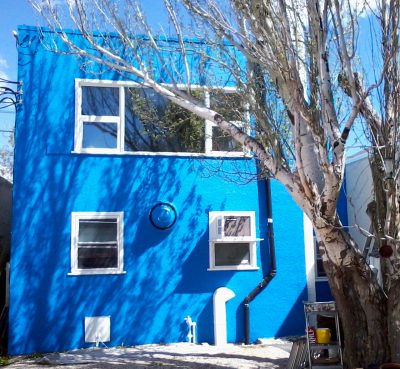 Q: When did you begin exterior paint work?
Q: When did you begin exterior paint work?
A: Unofficially, I started in 1986. I was building water slides in Winnipeg’s south end at the time, and the contractor needed to prime and topcoat the steel supports. He liked my work ethic and hired me for residential projects north of the city. By 1988 I was working with IATSE local #63 as a loader/climber on show sets, and I got to paint some sets for GM car shows at the old Winnipeg arena. After that I was recruited to the set painting department at the CBC Winnipeg studios. I worked under an old Lithuanian guy who taught me tricks like trimming brushes, filtering paint through nylons, mixing colours, faux effects, marbling, maintaining spray gear, etc. The down-draft paint booth was a joy, and the whisky and stories after work were fun, too.
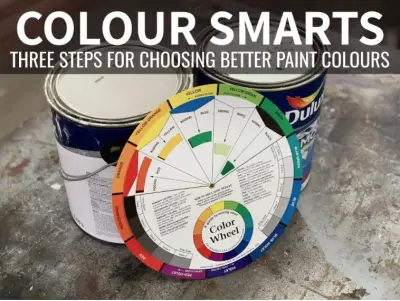
Q: Where have you done exterior paint work professionally?
A: After my experience as a set painter, I moved back east to Toronto, hoping to work on the set of the Rolling Stone’s first Canadian show, only to be shown the end of the line at the union hall. After that I landed my own painting jobs. For the last 20+ years, I’ve primarily worked out of Winnipeg doing residential interiors and exteriors, commercial work, plus painting jobs in the cottage country of Lake of the Woods and Gimli, Manitoba. Some of these jobs you had to get to by boat or over winter ice roads that cross lakes and swamps.
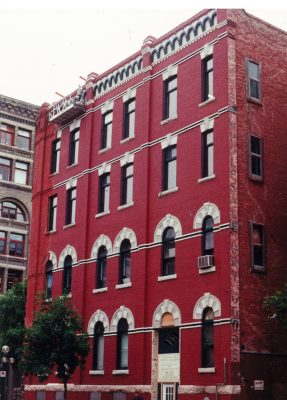 Q: Are there advantages to doing exterior paint work in Winnipeg?
Q: Are there advantages to doing exterior paint work in Winnipeg?
A: Yes, especially up until about 10 years ago. Winnipeg used to be what I call a “board and stucco town” (as opposed to exterior brick out east). Even today there are lots of older character-home neighborhoods. Tudor, Edwardian and Victorian houses, 100 years old, 2 to 3 1⁄2 storeys – these homes require plenty of TLC and ongoing restoration work. The vintage Crescentwood area of Winnipeg is complete with its own historic text book.
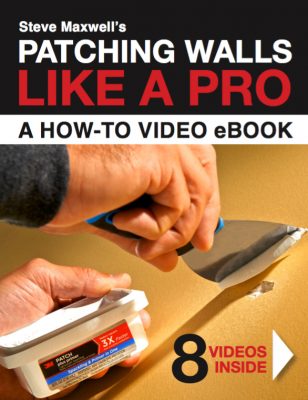
The notoriously unstable and shifting soils of Winnipeg make a lot of work for painters. Increasing traffic vibration also produces persistent structural damage that keeps patching and painting workers busy. Winnipeg is not a physically big town, so it’s easier to run paint and do on-site, in-person estimates. Google Earth is great as an early reconnoitre tool here.
All this said, I have to admit that there’s a loss of neighborliness here, with faster homeowner turnover, increasing vandalism and an aging demographic. Many of these homeowners are now pensioners, selling and moving to condos in the suburbs. Developers are jumping at the chance to replace old structures with new condos to maximize profits.
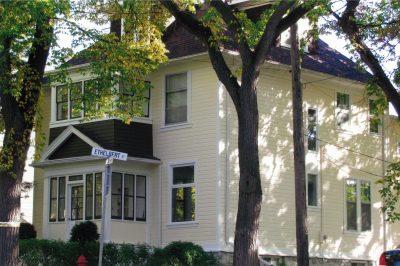 Q: Is it true what they say about big, fat mosquitoes arriving each spring in Winnipeg, even in downtown areas?
Q: Is it true what they say about big, fat mosquitoes arriving each spring in Winnipeg, even in downtown areas?
A: Yes, but not for the last two years because it’s been unusually dry from April through June. However, we do have caterpillars that devour tree leaves and drop additional “sap” everywhere. They’ll slime a wall green if you’re foolish enough to roll ‘em in. In cottage country up around Lake Winnipeg and Lake Manitoba, the May flies can arrive in droves requiring extensive sweeping and shoveling. It can be a real challenge when painting!
Q: What kind of exterior paint work have you done over the years?
A: Basically I’m old school. I do manual prep with Sandvik scrapers, wire brushes and sometimes electric sanders. I apply paint with brushes and roller only. No spraying paint, no power washing, no elastomeric. Ladder only most of the time and no scaffolding is the way I work. My projects are big and small . . . primarily residential and commercial exteriors and interiors. Bungalows, three-storey homes, chalets, cottages, restaurants, warehouses, clinics, apartments, decks, fences, pools, garages, even furniture and cabinets. I’ve painted a five-storey heritage brick building in downtown Winnipeg from a swing stage, I’ve traded custom faux finish work for my 1989 Land cruiser, done an exterior paint job in exchange for a custom Italian suit, painted part of a clinic for dental work, and done cottage repaints in exchange for working holidays.
Q: I hear you attended art school. What did you take away from the experience that might help with your exterior paint work today?
A: I attended the Ontario College of Art in Toronto from 1980 to 1983. I reveled in the experimentation and freedom there. On my first day in colour class, my professor and master colorist Francois Thepot, told me I didn’t need him. He had observed that I could mix pigment and execute any color application instinctively and that there was no reason to stick around in his class. The take-away from this all was that I like to paint, that I think monumentally and that I like to work BIG, but not collaboratively.
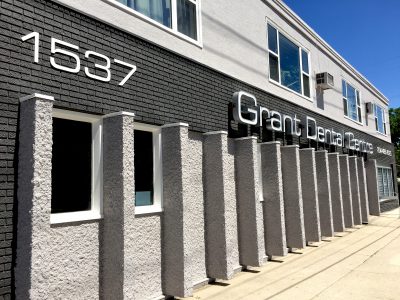 Q: What kind of exterior paint do you like to use and why?
Q: What kind of exterior paint do you like to use and why?
A: I like Benjamin Moore and their Aura top line paints for both exteriors and interiors. The primer base comes in handy, especially on high trim-work. One shot and you’re done.
The CBC used Benjamin Moore exclusively back in the 1980’s in the set-paints department. It was the only stuff that didn’t screw up the spray equipment, even though we filtered all paint through nylons.
I’ve remained loyal to my paint supplier for 30+ years with happy results. Superior adhesion and durability, ease of application, speed of drying and kick time, superior coverage and extent of tint availability. Plus, BM’s Century line is like artist’s gouache . . . fantastic for interior feature applications. It’s funny, but anytime I’ve stooped or caved to using any other brand, it doubles or even triples my application time.
To salvage most stucco, I add Emulsa or Weld-bond to Super-Spec for best adhesion and durability. I’ve done ceilings in everything from theatre flat black to ultra robin’s egg-shell blue and stipple with the requisite oil-base paint. The latex flats nowadays are actually washable and provide an elegant look and feel. For exterior verticals and horizontals, I like low lustre finishes because they weather better. For a special job, I once imported fluorescent sign paint from California by the gallon for a retail project. I pushed it beyond recommendations. The paint didn’t last in our harsh climate, but it sure got attention.
Q: Do you have favourite primers for exterior paint work?
A: Yes. Insl-x is a quick drying oil-based primer that’s especially good for weathered sills and for sealing bare wood. I call it “the stinky stuff”. Vapours are brutal, and volatility requires lots of ventilation. Super-Spec is fine, so is Zinsser and whatever product the BM tech recommends. I never tint my primers as it reduces adhesion.
Q: Do you ever do spray exterior paint?
A: No, never. I leave that to big commercial outfits. I once rented spray gear to paint a girdered ceiling for a warehouse-style retail clothing store. Poor quality results and badly maintained rental gear cost me the job. Never again. Other complaints I have about spraying are that masking takes too much time; a third of the paint disappears into the air onto cars and neighbors; a third of what you spray is solvent to cut the paint and get it through the nozzle; a third of the paint falls incompletely on the surface and has to be rolled anyway. I consider spraying a joke. Save it for the McDonalds franchise or the new mall. I once watched a union crew of three guys spray siding on an old elementary school. It took them a full week. By the time they’d set-up scaffolding and taped/masked off a section of wall, I’d have been done, including prep work and the whole building all sides with a brush and roller working alone.
 Q: Do you have any tricks for patching interior walls before painting?
Q: Do you have any tricks for patching interior walls before painting?
A: I do what I call cosmetic patching only. For me it’s a matter of speed. For spider cracks on drywall and plaster, I use Zinsser’s MH Ready Patch. It’s a resin-based compound that’s fast-drying but hard to sand if you over-apply. I’ll layer it in the same session if need be. I dislike drywall mud because of the dust. For larger cracks, I start with an adhesive fibre tape, but even this won’t last forever on our shifting Winnipeg gumbo soils. For nail holes and similar challenges, I finger-apply caulking, with cardboard stuffing if necessary. If there’s old lath and plaster to repair, I leave it to that rare breed called plasterers.
Q: Have you ever hired much help?
A: No, I work solo only. I learned my lesson early on that it was cheaper, quicker, more professional and much more profitable to be on my own. I ended up having to go over everyone else’s work when I tried in the early days, so it was self-defeating. I’m too fast for my own good and others just get in my way. Plus, it’s safer when I control my own work space and customer interaction.
Q: Do you actively market yourself to get jobs? Word of mouth?
A: I have a website and I advertise online. I recently started Instagram and Facebook pages. Generally, the summer half of the year generates the most activity and winters are the slowest, though there are always pleasant surprises.
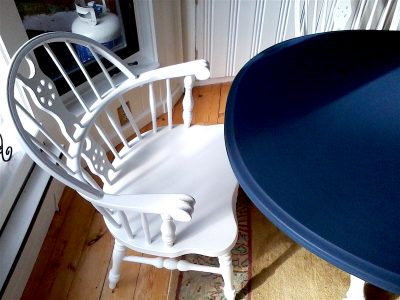 Q: What are some surprising things you’ve learned about running a painting business?
Q: What are some surprising things you’ve learned about running a painting business?
A: There are lots of surprises. First, I can’t rely on Google nor real estate agents nor botched student painting jobs to find me good leads. I need to to that for myself. Also, I’m surprised how often I need to educate potential customers that you get what you pay for.
I was most happily surprised to be referred to as “low maintenance” by one of my best customers. He doesn’t have to worry that I’ll do it right and reasonably. Building and maintaining trust like this is most important.
I’ve always become aware that one’s dress is a subtle but major indicator when colour consulting, and that heeding the historical background on a project matters. For example, I was surprised how much a designer who inherited her father’s Victorian-style home was concerned about the prospect of deviating from his original and classic all-white exterior. In his honour, we thoroughly researched and found a five-colour, San Francisco-style solution that looks great. I’ve learned to make friends with customers’ pets ASAP, and I’ve had cats follow me as I work. And finally, the most surprising to me is ambidexterity. I can cut just as accurately with my left as with my right.
Q: How has the painting business changed in Winnipeg over your time in the trade?
A: The great tradition of referrals from other trades has vanished. More non-paint materials are appearing, too. Decks are now recycled plastic, glass replaces spindles, faux stone replaces wood ship-lap, etc. Older character homes are simply being bulldozed and replaced. On the plus side, the new monster homes have single rooms that require more paint than some complete older homes in Winnipeg did.
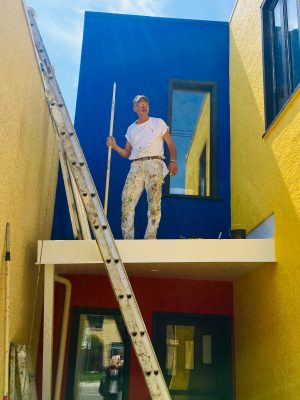 Q: You paint a lot of exterior brick but painting brick isn’t as simple as it looks in Canada. It can cause flaking and spalling of the brick if trapped moisture freezes and expands. How do you paint brick without ruining it?
Q: You paint a lot of exterior brick but painting brick isn’t as simple as it looks in Canada. It can cause flaking and spalling of the brick if trapped moisture freezes and expands. How do you paint brick without ruining it?
A: Brick manufactures require at least one month for fresh mortar to set and lose moisture, and breathability of the paint is key no matter how old the brick is. In addition I use a stucco-type paint and add a bonding agent mixed 1:5 with the paint to fortify adhesion and fill minor cracks in old or porous brick. Masonry also soaks up and coverage requires tons more paint and time to work it in. I break roller cages and wear out lots of thick fabric sleeves in the process. Most important of all, thorough wire- brush prep of brick is essential. I never power wash brick. It’s self-defeating when two or three months dry-time is required as a consequence. Otherwise, it’s like painting a wet-sponge. Yellows and reds weather the fastest I find.